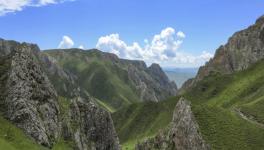Yak Domestication Evidence Discovered in Tibetan Plateau Near Arunachal Pradesh from 2500 Years Ago

The Yak is an important animal in some parts of India—Arunachal Pradesh, Sikkim, Ladakh etc. Arunachal Pradesh even has a Yak research centre in Dirang, West Kameng district. Now domesticated, Yak is important for its milk, hair, skin, and meat. When did humans first domesticate Yaks, and where? This has been an important question for researchers, and a recent study offers some clues about this history. Published in Science Advances, a research paper suggests that the domestication of Yaks was done some 2500 years ago in the southern Tibetan plateau, which is the oldest evidence till now.
Importantly, Yaks are among the few animals in the Himalayan high altitudes with harsh conditions of extreme cold and low oxygen. International researchers, including archaeologists from Washington University and the University of China, found the evidence in a settlement known as Bangga, which is in the Shannan prefecture. Shannan borders Bhutan and Arunachal Pradesh, and the river Yarlung passes through it. Yarlung is Brahmaputra in Tibet.
Moreover, alongside Yaks, the humans of Bangga also domesticated cattle (cow) of the Taurine variety and could produce Yak-cattle hybrids, the research findings suggest. The Taurine variety of cattle is different from the Zebu or the humped breeds found in the Indian subcontinent and tropical Asia. Yaks, domestic cattle, along with the aurochs, which are the ancestor of cattle, are grouped into the genus called the Bos.
The researchers combined archaeological evidence with genomic findings (from DNA analysis) to arrive at the conclusions. Bangga is located at an elevation of around 3750 meters or over 12000 feet above sea level and is one of the earliest agro-pastoral settlements. This site also has abundant animal remains which have been systematically excavated in recent decades. “Many scholars have speculated that yak was first domesticated in the high-altitude regions of the Tibetan Plateau. It was a well-informed speculation, but up to this point, there hasn’t been robust evidence for that. This is the first evidence supported by both archaeology and ancient DNA,” commented Xinyi Liu in a statement to an article of Washington University, an associate professor of archaeology in Arts and sciences at Washington University and a co-author of the study.
“Bangga provided us with a unique window into lifeways at high elevations 3,000 to 2,000 years ago. They cultivated barley in an intensive way, provisioned sheep with fodder and water and consumed milk. All these resources were introduced to the Tibetan Plateau from other world regions as part of prehistoric food globalisation and had become part of the Tibetan legacy. Now we know they had domestic Yak,” Liu furthered in the statement.
The team of researchers analysed around 10,000 pieces of bones collected from Bangga. Out of these, they sorted 193 as belonging to Bos. After that, they went for DNA analysis of a few (five) of the well-preserved bones from the Bos samples.
Their genetic analysis revealed that only one bone belonged to a Yak, and the four belonged to female taurine cattle. According to Liu, the finding of the Taurine variety of cattle was a little surprising because Bangga is located close to the Himalayas and within the range of zebus and Indian aurochs, which were not found there. Worth mentioning here is that the Taurine variety of cattle was introduced to the region via the silk route from Anatolia.
Analysing further, the researchers found that the yak bone belonged to a domesticated animal rather than a wild yak that hunters killed and brought to the region for food. They also found hybridisation of Yak-cattle, specifically yak and Taurine.
In the highlands on the Indian side, including the states and Union territories of Sikkim, Arunachal Pradesh, Ladakh, and Himachal Pradesh, there are an estimated 14 to 15 million domestic Yaks. However, the wild Yaks are now in the ‘vulnerable’ category of the IUCN (International Union for Conservation of Nature), according to which only about 7500-10000 individuals exist in the world.
Get the latest reports & analysis with people's perspective on Protests, movements & deep analytical videos, discussions of the current affairs in your Telegram app. Subscribe to NewsClick's Telegram channel & get Real-Time updates on stories, as they get published on our website.















